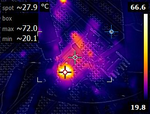gumattos
Member level 1

Well, I have no idea why you could not get the circuits I posted to work.
I tested the exact circuit below on a plug-in breadboard which is not optimum, and it worked the first time. I changed a few values to maximize the efficiency at 500 mA out and had it running for more than an hour. The only thing that slightly heated up was the 470 uH choke.
The Simulator predicted an efficiency of 87.65 % and I measured it at 86.1 %.
I suspect that the difference is being consumed in the choke. I will try a larger current choke later and see if it improves things.
The switching waveform on the drain of Q1 is nice with rise and fall times under 50 nS.
I will post actual scope plots a bit later.
From the beginning I never stopped considering the fact that I could be making some mistakes. If it works for it must work for me, I will buy brand new components and try again! Thank you very much E-Design for the effort you put in helping me, as soon as I can I will put results












